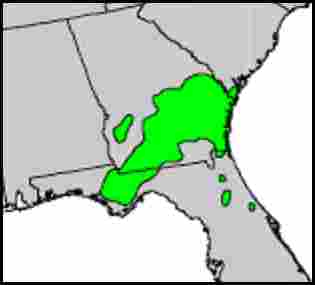Pinckneya
(Pinckneya pubens)
Pinckneya is a small deciduous tree native to the coastal plains of the southeastern United States. It is notable for the very showy blossoms borne on the tips of the branches in late spring. Their color is usually pink, but the possible shades range from creamy-white to rose-red. The blossoms occur in large clusters, and a tree in full bloom is a spectacular sight.
Actually the petals of the individual blossoms are small and inconspicuous. The size and color of the bloom comes from the sepals, which can expand to several inches. Because these sepals retain their color for an extended period before fading, the show lasts for several weeks.
This is a plant of the deep south, and it can't be grown in the north except in a greenhouse. Even in the south It isn't common, either in gardens or in the wild. Its native habitat is wet acidic soils on the margins of bays, swamps, and streams, often in the light shade of scattered pine trees. Cultivated plants can grow on drier sites, but may need special attention during droughts. Root rot can be a problem, especially on poorly-drained clay soils.
But in the right conditions the species can grow fairly fast and begin blooming at a young age. It needs a moist acidic soil with good drainage, and does best in light shade. Wild specimens often spread by producing root suckers, and cultivated plants usually have multiple trunks.
Pinckneya can be grown somewhat north of its native range, in the warmer parts of Zone 7. It can be killed to the ground if the temperature drops below zero (F), but will usually resprout from the roots.
The scientific name of this species has been changed from Pinckneya bracteata to Pinckneya pubens. An old common name is Fever-bark Tree, and the bitter bark of the plant was formerly used as a home remedy for reducing fever. The species is related to the Cinchona Tree (Cinchona ledgerina) of South America, the original source of quinine.
Other Information
Scientific Names: Pinckneya pubens, Pinckneya bracteata
Common Names: Pinckneya, Fever Tree, Fever-bark Tree, Georgia Fever-bark
Plant Type: Small deciduous tree
Height: 10-20 feet
Cultivation Zones: 7B - 9B
Native Habitat: Margins of swamps, bays and streams
Native Range: Mainly southern Georgia and northern Florida. See Distribution Map below.
Distribution Map

Range Map Source: U.S. Forest Service. (See General Note C)
Conservation Status: NatureServe lists Pinckneya pubens as Critically-Imperiled in South Carolina, and possibly Vulnerable in Georgia.
Cultivation: Pinckneya grows best in moist acidic soil in light shade. Good drainage is essential. The plant has a reputation for being difficult to grow, so you should be prepared to give it special attention. Go to Cultivation for more information.
Plant Sources: Pinckneya can be difficult to obtain. Two possible sources are Woodlanders and Nearly Native Nursery. Selected forms include "May's Pink", "Larry's Party", and "White". For links to the mentioned suppliers, go to Sources of Plants.
Photos
|

